Ctenosaura similis
| Ctenosaura similis | |
|---|---|
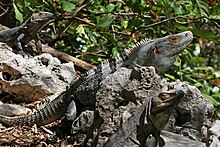
| |
| Scientific classification | |
| Kingdom: | Animalia |
| Phylum: | Chordata |
| Class: | Reptilia |
| Order: | Squamata |
| Suborder: | Iguania |
| Family: | Iguanidae |
| Genus: | Ctenosaura |
| Species: | C. similis
|
| Binomial name | |
| Ctenosaura similis (Gray, 1831)
| |

| |
| Synonyms | |
Ctenosaura similis, commonly known as the common spiny-tailed iguana or black iguana, is a lizard native to Mexico, Central America, and some Colombian islands in the Caribbean Sea and Pacific Ocean. It has been introduced to the United States in the state of Florida. It is the largest species in the genus Ctenosaura.
Taxonomy[]
The black spiny-tailed iguana was first described by British zoologist John Edward Gray in 1831.[4] The generic name, Ctenosaura, is derived from two Greek words: ctenos (Κτενός), meaning "comb" (referring to the comblike spines on the lizard's back and tail), and saura (σαύρα), meaning "lizard".[5] Its specific name is the Latin word similis meaning "similar to", a common description found in Linnean taxonomy when referring to a new taxon.[6]
Description[]

Black spiny-tailed iguana have distinctive black, keeled scales on their long tails, which gives them their common name.[7] They, along with C. pectinata, are the largest members of the genus Ctenosaura. The males are capable of growing up to 1.3 meters (4 ft 3 in) in length and the females are slightly shorter, at 0.8–1 meter (2 ft 7 in – 3 ft 3 in).[5] They have a crest of long spines which extends down the center of the back.[7] Although coloration varies extremely among individuals of the same population, adults usually have a whitish gray or tan ground color with a series of 4–12 well-defined dark dorsal bands that extend nearly to the ventral scales.[7] Males also develop an orange color around the head and throat during breeding season with highlights of blue and peach on their jowls.[5][7]
Diet and behavior[]
Black spiny-tailed iguanas are excellent climbers, and prefer a rocky habitat with plenty of crevices to hide in, rocks to bask on, and nearby trees to climb.[5] They are diurnal and fast moving, employing their speed to escape predators but will lash with their tails and bite if cornered.[5] The Guinness Book of World Records lists this as the world's fastest lizard, with a maximal sprint speed of 34.6 km/h.[5][8]
They are primarily herbivorous, eating flowers, leaves, stems, and fruit, but they will opportunistically eat smaller animals, eggs and arthropods.[5] Juveniles tend to be insectivores, becoming more herbivorous as they get older.[9] They are known to eat the fruit and live in the limbs of the manchineel, a tree highly poisonous to most other animals.[10]
Distribution[]
The black spiny-tailed iguana is native to Central America, and has the widest range of all Ctenosaura species from the Isthmus of Tehuantepec to northeastern Nicaragua and western Panama on the respective Atlantic and Pacific coasts.[6][5] It is commonly found throughout Costa Rica, Honduras and has been reported from some islands of Colombia in both the Caribbean Sea and Pacific Ocean.[11]
The black spiny-tailed iguana has been introduced to South Florida and reproduces in the wild in several feral populations. On the southwestern Florida coast, it has been discovered from Collier County north to Tampa Bay.[12][13][14] On the southeastern Florida coast, black spiny-tailed iguanas have been found on Key Biscayne, Hialeah, and in Broward County. This iguana has also been introduced to several islands in the Caribbean.[15] As this species will opportunistically feed on small vertebrates, such as fish, rodents, eggs, birds, and even hatchling sea turtles it may pose a threat to endangered native species.[13]
Reproduction[]
Mating generally occurs in the spring. Males show dominance and interest by head bobbing; eventually the male will chase the female until he can catch her and subdue her.[5] Within eight to ten weeks, the female will dig a nest and lay clutches of up to 30 eggs.[5] The eggs hatch in 90 days with the hatchlings digging their way out of the sand.[5] These juveniles are typically green with brown markings, although all brown hatchlings have been recorded as well.[7]
Commercial usage[]
In some parts of Central America, the black spiny-tailed iguana, colloquially called the "chicken of the trees," is farmed alongside the green iguana as a food source and for export for the pet trade[5] [see iguana meat]. Although it is heavily hunted it does not appear to be endangered in any of its native territory.
Gallery[]
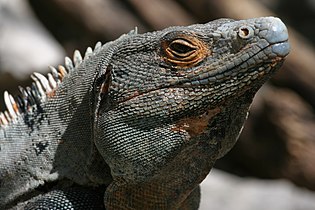
Head of an adult male, Barra Honda National Park, Costa Rica (16 February 2007)
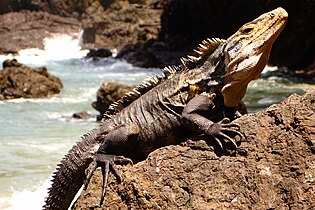
An adult maleCtenosaura similis from Costa Rica
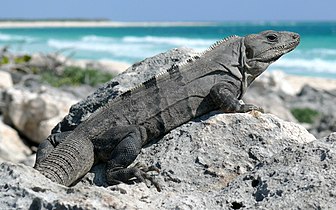
A basking female Black spiny-tailed iguana on the island of Cozumel in Quintana Roo, Mexico (2 February 2008)

A male from Uxmal, Yucatán, México (11 February 2015)

A female from Uxmal, Yucatán, México (11 February 2015)

A large male black spiny-tailed iguanas with three smaller females, Edzna, Campeche, Mexico

Juveniles are typically green and turn dark with age, Santa Rosa National Park, Costa Rica (7 October 2006)
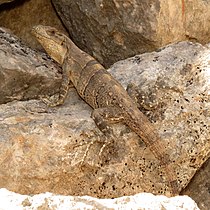
Female or sub-adult from Uxmal, Yucatán, México (11 February 2015)

Adult male among Mayan ruins (14 February 2014)

Black spiny-tailed iguanas are excellent climbers Manuel Antonio National Park, Costa Rica
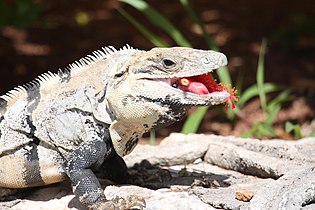
A male eating a flower in southern Mexico (16 February 200)

A juvenile from Rincon de la Vieja, Costa Rica (4 August 2009)

Black Spiny-tailed Iguana overseeing Tulum, Quintana Roo, Mexico
References[]
- ^ Pasachnik, S. (2015). "Ctenosaura similis". IUCN Red List of Threatened Species. 2015: e.T174480A73611567. doi:10.2305/IUCN.UK.2015-1.RLTS.T174480A73611567.en. Retrieved 19 November 2021.
- ^ "Appendices | CITES". cites.org. Retrieved 2022-01-14.
- ^ The Reptile Database. www.reptile-database.org.
- ^ "Ctenosaura similis". Integrated Taxonomic Information System. Retrieved 30 December 2007.
- ^ a b c d e f g h i j k l Malfatti, Mark (2007). "A look at the genus Ctenosaura: meet the world's fastest lizard and its kin". Reptiles Magazine. 15 (11): 64–73.
- ^ a b Hollingsworth, Bradford D. (2004). The Evolution of Iguanas: An Overview and a Checklist of Species. Iguanas: Biology and Conservation. University of California Press. pp. 34–35. ISBN 978-0-520-23854-1.
- ^ a b c d e Köhler, Gunther (1996). "Notes on the systematic status of the taxa acanthura, pectinata, and similis of the genus Ctenosaura". Senckenbergiana Biologica. 30 (1): 33–43.
- ^ Garland, T. Jr. (1984). "Physiological correlates of locomotory performance in a lizard: an allometric approach" (PDF). American Journal of Physiology. 247 (5 Pt 2): R806–R815. doi:10.1152/ajpregu.1984.247.5.R806. PMID 6238543.
- ^ Van Devender, R. W. 1982. Growth and ecology of spiny-tailed and green iguanas in Costa Rica, with comments on the evolution of herbivory and large body size. Pages 162-182 in G. M. Burghardt and A. S. Rand, eds. Iguanas of the world: their behavior, ecology, and conservation. Park Ridge, New Jersey, Noyes Publications.
- ^ Friedman, Melissa H.; Andreu, Michael G. (24 November 2015). "Hippomane mancinella, Manchineel". edis.ifas.ufl.edu. University of Florida. Retrieved 9 April 2018.
- ^ Köhler, G. 2008. Reptiles of Central America, 2nd Edition. Herpeton, Verlag Elke Köhler, Offenbach, Germany. 400 pp.
- ^ "Black spiny-tailed iguana (Ctenosaura similis) - EDDMapS State Distribution - EDDMapS".
- ^ a b Krysko, K. L. & King, F. W. & Enge, K. M. & Reppas, A. T. (2003):Sarasota county Distribution of the introduced black spiny-tailed iguana (Ctenosaura similis) on the southwestern coast of Florida.- Florida Scientist, Lawrence, Kansas; 66 (2): 74-79.
- ^ https://www.scgov.net/Home/ShowDocument?id=34391
- ^ Sanchez, Alejandro (2007-12-31). "Father Sanchez's Web Site of West Indian Natural History Diapsids I: Introduction; Lizards".
External links[]
 Media related to Ctenosaura similis at Wikimedia Commons
Media related to Ctenosaura similis at Wikimedia Commons Data related to Ctenosaura similis at Wikispecies
Data related to Ctenosaura similis at Wikispecies- West Coast Iguana Research
- Black Spinytail Iguana, Florida Fish & Wildlife Conservation Commission
- IUCN Red List least concern species
- Ctenosaura
- Lizards of Central America
- Reptiles of Belize
- Reptiles of Colombia
- Reptiles of Costa Rica
- Reptiles of El Salvador
- Reptiles of Guatemala
- Reptiles of Honduras
- Reptiles of Mexico
- Reptiles of Nicaragua
- Reptiles of Panama
- Lizards of the Caribbean
- Reptiles described in 1831
- Taxa named by John Edward Gray













